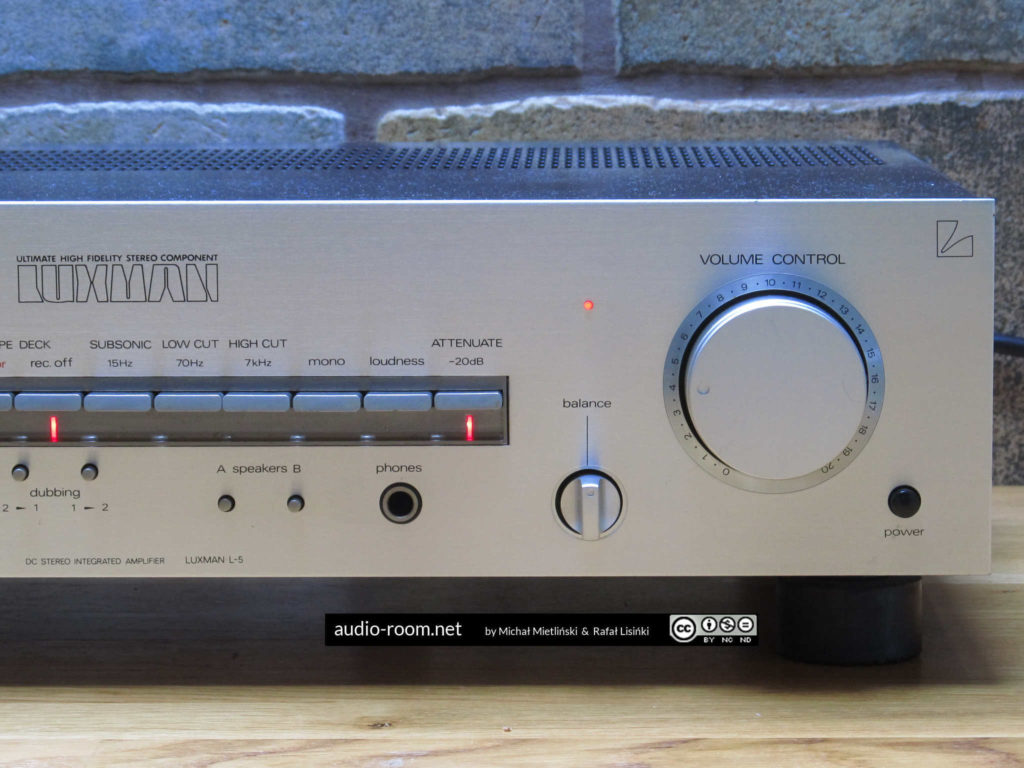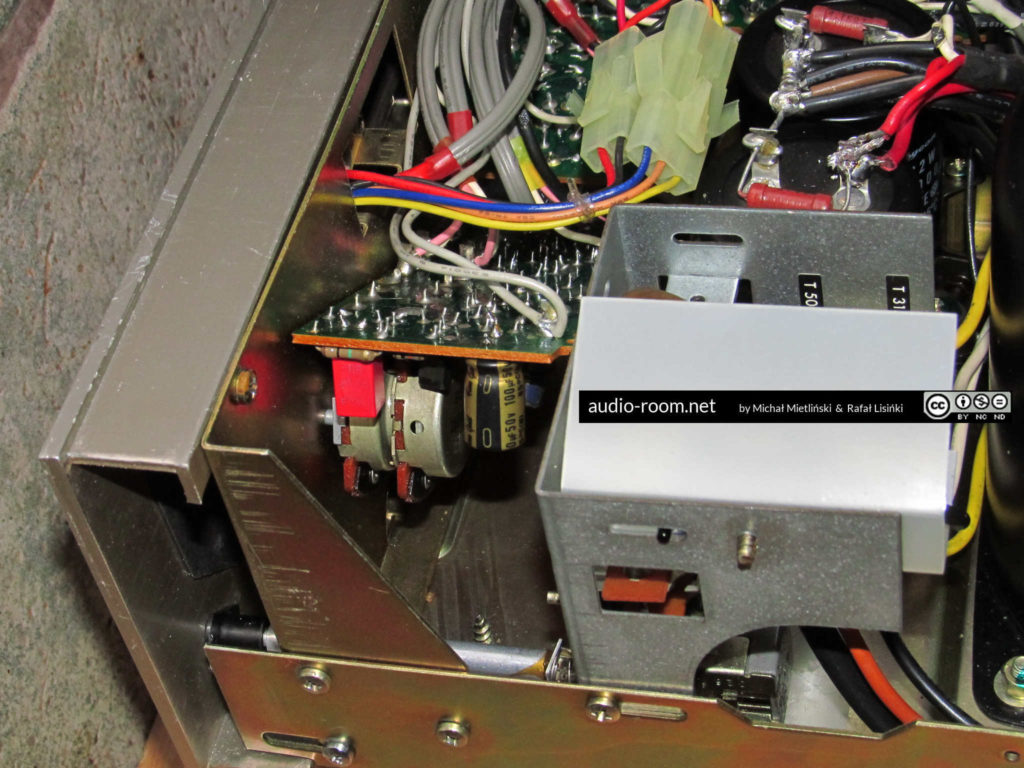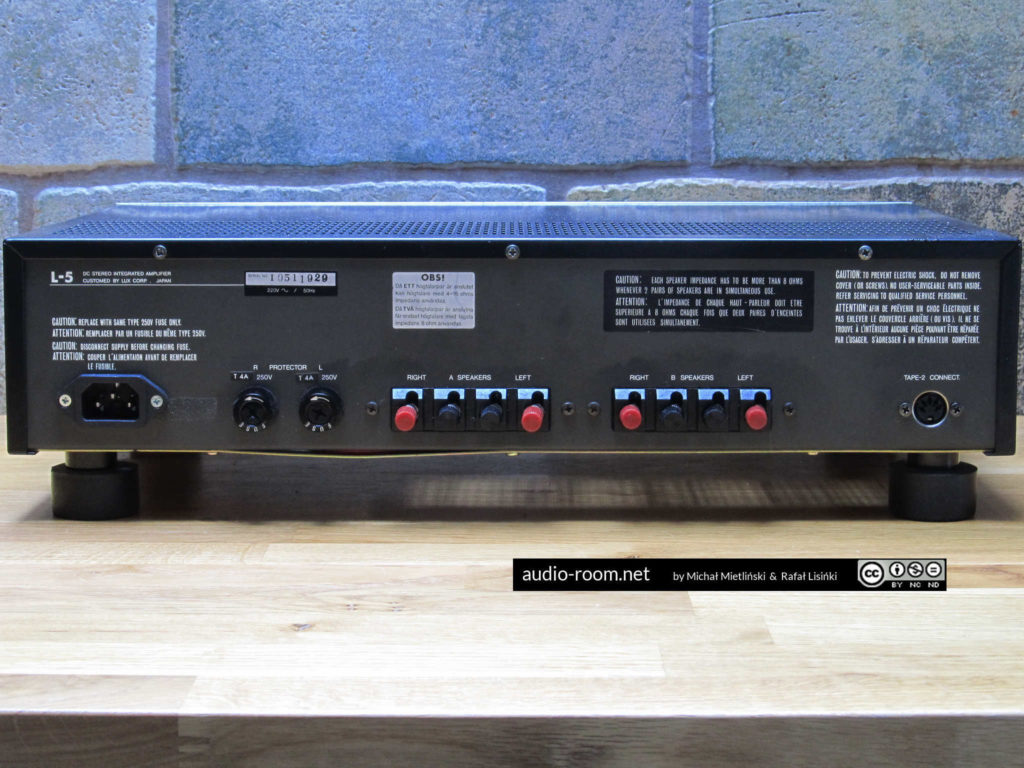Luxman is currently a niche brand, but a highly valued one regardless of the price range and period (almost). The company now manufactures equipment that costs four-figure amounts, but in the past century it offered cheaper units that compared well or very well to the competition, and are still quite popular in the used gear market.
Luxman L-5 comes from the late 1970s. During its production period (from 1978 to 1981), it was 3th-4th models from the bottom of the line (above the L-1 – L-4 models, which, however, not all were produced at the same time). We received it for testing from a reader, with a request to focus on the sound (which seemed overly sharp to the owner) and service and adjust if necessary.

Our listening test did not reveal any problems with excessively sharp or grainy sound. In this respect, Luxman did not deviate from the standard and sounded similar to several other amplifiers, with which we compared it. Our conclusion, which we shared with the owner, was that the annoying effect that the owner heard was due to either amp/speakers mismatch, or excessive sensitivity of the owner’s hearing to specific frequencies (the owner mentioned that he could be hypersensitive at times). As far as the technical side was concerned, the only problem we found was that the quiescent current was too low. We adjusted it in accordance with the manufacturer’s recommendations. The adjustment procedure in this amplifier is slightly invasive, it requires desoldering wires from the power amplifier board (or at the other end – from the positive terminals of the main filtering capacitors) and connecting a DMM in series. Because access to the capacitors is much better than to the power amplifier board, we used that point. Only after connecting a DMM and closing the circuit the amplifier can be safely turned on and the quiescent current should be set to 45 mA. But there is a simpler method: this corresponds to a value of 10 mV measured on an emitter resistor.

When it comes to internal layout, it’s clear that Luxman engineers did what they could to fit as much as possible in a relatively small housing. The components are quite densely packed, the boards stand and lie wherever possible and at various, sometimes unusual angles (for example the volume potentiometer board is mounted diagonally, otherwise it would probably not fit). But due to those “packing skills”, there was a place for a well shielded transformer, large filter capacitors, decent size heat sinks and a fairly extensive preamplifier. The quality of the original components was quite good, in the unit that we tested many capacitors had been replaced with better quality parts.

The amplifier looks good on the outside, the front panel design is aesthetic, although the number of buttons could put a Bond villain’s world domination machine to shame. But you’ll have a multitude of functions at your disposal, including one high and two low filters, loudness filter, a mono switch, a 20 dB muting switch, even bass and treble control switches that allow to change the tone control frequency or bypass it completely. In short, there is no shortage of things you can push or turn.
The rear panel, on the other hand, is somewhat puzzling at first: there are outputs for 2 pairs of speakers and only one DIN input (TAPE 2). Who stole the remaining inputs!?

Who stole the inputs!?
It turns out that unfortunately Luxman engineers apparently borrowed a misguided idea from Braun and placed almost all input sockets on the bottom of the amplifier. It’s an extremely inconvenient solution, if you want to connect or disconnect a source you have to put the amplifier on the side. On top of that, the plugs can not be too long or cables too rigid, or the amplifier will stand on them instead of its legs. On the plus side, there are a lot of inputs: 2 phono inputs, 4 line inputs (including 2 cassette loops), there is even a preamplifier output and a power amplifier direct input.

As for the sound, I would describe the amplifier as very good (for the price) but not outstanding. I compared it to 4 other amplifiers: Marantz 1060, Superscope A-530 (a Marantz 1050 clone) NAD 7020 (a NAD 3020 with a radio tuner added), and then to a newer Sony TA-F461R. For lisytening tests, we used bookshelf speakers Cyrus 780 (an improved version of Mission 760 with a few centimeters deeper enclosure) and floor-standing Quadral Amun MK V. The testing method is as follows: the same source is connected to the two amplifiers being compared through a splitter (using identical cables), the volume of both amplifiers is matched, the loudspeakers are connected simultaneously to both amplifiers via a switch (also with identical cables), which gives the possibility of switching between the amplifiers instantly, without having to turn them off, to disconnect and reconnect cables, etc.

Of the first three remaining amplifiers, Marantz 1060 had the most similar sound colouration to the Luxman. Luxman sounded a bit brighter than NAD 7020 and clearly brighter than Superscope A-530. It could not match either of the three other amplifiers in terms of soundstage (sound width and depth), it also had a slightly thinner mids. The Luxman did sound good, but the NAD and Marantz 1060 had a slight advantage over it regardless of the speakers used, and the Superscope A-530 (thast one had the darkest sound) performed better with bookshelf speakers.
Luxman L-5 did not really surprise me in that it sounded exactly as I remembered the sound of another model that I once had, Luxman L-1A.
Midrange and soundstage did improve a bit after adjusting idling current to spec, but they were still not at the level of Marantz 1060 and NAD 7020.
Later, I also compared the Luxman with a Sony TA-F461R, a rather decent affordable Sony Mos-Fet amplifier. In an A/B listening test on Quadral Amun MkV I only heard a very slight difference in midrange, so small that I could hear it only at certain moments, it was practically negligible and I could not tell if it was in favour of any of the two amps. These two amplifiers sounded very similar indeed.

In earlier comparisons with other amplifiers, the Sony TA-F461R tested well, but it had a worse midrange than, say, Harman/Kardon HK6550. This confirms that Luxman also has drier mids than amplifiers I consider great in this respect. But overall, it is a good amplifier.
Luxman L-5 is worth recommending, but in our opinion not as good as Marantz 1060, NAD 7020 or Harman/Kardon HK6550. If the price is similar, better choose one of the competitors, but if the Lux is clearly cheaper, definitely consider it. It has aesthetic looks, it sounds good, handles difficult loads and has a lot of useful functions. Its biggest functional drawback is that the input sockets are located on the bottom.
We extend our thanks to Mr. Jarek for making this amplifier available to us for testing.
Luxman L-5 (1978-1981)
Technical information:
Power output (RMS): 60 watts per channel into 8Ω (stereo)
Power output (DIN): 95 watts per channel into 4Ω (stereo)
Frequency response (line): 10Hz to 100kHz
Frequency response (phono MM): 20Hz to 20kHz
Total harmonic distortion THD: 0,03%
Intermodulation distortion IM: 0,03%
Damping factor: 80
Input sensitivity: 2,5 mV/50 kΩ (MM), 150 mV/50 kΩ (line)
Signal to noise ratio: >92 dB (MM), >100 dB (line)
Channel separation: 60dB (MM), 78dB (line)
Bass control: +/- 12dB (at 200 Hz or 400 Hz)
Treble control: +/- 12dB (at 2 kHz or 4 kHz)
High filter: 7 kHz (- 6 dB/okt.)
Low filter: 70 Hz (- 6 dB/okt.)
Subsonic filter: 15 kHz (- 6 dB/okt.)
Dimensions: 438 x 289 x 105 mm
Weight: 9,5 kg





















“Excellent article. I had the chance to try the Luxman L-5 and its younger brother, the L-3, of which I own a unit in my collection, and I must say that in terms of quality the L-3 seems far superior to the L-5. The L-3 has that Luxman magic from the early ’70s combined with the aesthetic update it received in the ’80s. The best of both eras: tube-like warmth, much more microdetail than the L-5 or even the Marantz 1060, which I also own. That Luxman lineup is unfairly underrated, as it seriously outperforms amplifiers from much higher ranges.”